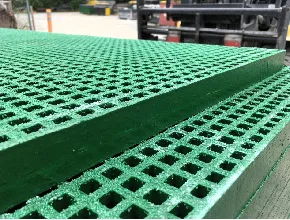loading...
- No. 9, Xingyuan South Street, Dongwaihuan Road, Zaoqiang County, Hengshui, Hebei, China
- admin@zjcomposites.com
- +86 15097380338
- Welcome to visit our website!
Innovative Applications and Benefits of Wire Mesh Grating in Modern Engineering Solutions
Understanding Wire Mesh Grating Applications and Benefits
Wire mesh grating, a crucial component in various industrial applications, combines durability, strength, and versatility. Made from interwoven metal wire, this type of grating is engineered to provide a stable surface for walkways, platforms, and many other uses. Its unique construction and material properties offer significant advantages, making it an ideal choice across a wide range of industries.
Composition and Design
Wire mesh grating typically consists of stainless steel, carbon steel, or aluminum. The selection of materials depends on the intended application and environmental conditions. For instance, stainless steel is often favored for its excellent corrosion resistance, making it suitable for use in chemical plants or coastal environments where exposure to saltwater is a concern.
The design of wire mesh grating involves a grid pattern, formed by weaving or welding wires together. The spacing and thickness of the wires can be customized to meet specific load requirements. This flexibility in design ensures that wire mesh grating can accommodate various applications, from light pedestrian traffic to heavy industrial loads.
Applications
The applications of wire mesh grating are vast
. In construction, it serves as flooring for walkways, scaffolding, and platforms due to its ability to provide a secure footing while allowing for drainage and airflow. In areas that require stringent safety standards, such as factories or warehouses, wire mesh grating can reduce slip hazards, especially in wet conditions.Additionally, wire mesh grating is used in architectural applications, such as railings and facades, where aesthetic appeal is essential alongside functionality. The open design of wire mesh allows light and air to pass through, creating a visually appealing effect while maintaining structural integrity.
wire mesh grating

In the agricultural sector, wire mesh grating is employed in livestock facilities and poultry farms to provide durable flooring that is easy to clean and promotes hygiene. Its open structure allows waste to fall through, facilitating easier maintenance and reducing the accumulation of harmful bacteria.
Benefits
One of the primary benefits of wire mesh grating is its strength-to-weight ratio. Unlike solid materials that can be heavy and cumbersome, wire mesh is lightweight yet capable of bearing significant weight and load. This characteristic not only eases transportation and installation but also reduces the overall structural load on buildings.
Moreover, wire mesh grating is low-maintenance. Its robust design minimizes the need for frequent repairs, and when properly installed, it can last many years, even in harsh environments. Additionally, the materials used can often withstand extreme weather conditions, enhancing the lifespan and reliability of the grating.
Wire mesh grating also contributes to sustainability efforts. Its design allows for efficient use of materials, reducing waste during production. Furthermore, many manufacturers offer products made from recycled metals, aligning with environmentally friendly practices and contributing to a circular economy.
Conclusion
In conclusion, wire mesh grating stands out as a versatile and essential component across various industries. From its sturdy construction and customizable designs to its widespread applications and numerous benefits, it plays a critical role in ensuring safety, efficiency, and sustainability. As industries continue to evolve, the demand for innovative materials like wire mesh grating will likely increase, solidifying its importance in modern infrastructure and design. Whether in construction, agriculture, or architecture, wire mesh grating proves to be an invaluable asset that combines practicality with strength and adaptability.
-
GRP Structures: The Future of Lightweight, High-Performance EngineeringNewsJun.20,2025
-
FRP Water Tank: High-Performance Storage for Corrosive and Clean Water SystemsNewsJun.20,2025
-
FRP Square Tube: The New Industry Standard for Chemical and Structural ApplicationsNewsJun.20,2025
-
FRP Pultruded Profiles: The Ultimate Choice for Lightweight Structural StrengthNewsJun.20,2025
-
FRP Handrails: The Safer, Smarter, and Stronger Choice for Modern InfrastructureNewsJun.20,2025
-
FRP Grating: The Smart Solution for Durable, Lightweight Industrial FlooringNewsJun.20,2025
-
Why Choose a Galvanized Water Tank for Your Storage NeedsNewsMay.21,2025
